Audit of ABC Learning: Financial Analysis and Recommendations
VerifiedAdded on 2021/04/21
|12
|1347
|307
Report
AI Summary
This report presents a financial analysis of ABC Learning, focusing on accounting fraud and malpractice. It utilizes various auditing standards and tools such as trend analysis, Beneish M-score, DuPont analysis, and common-size statements to assess the company's financial performance. The analysis reveals concerning trends, including increasing operating expenses, potential data manipulation, declining returns on equity, and diminishing profitability. The report summarizes these findings and recommends that ABC Learning focus on reducing operational costs, refraining from account manipulation, and improving its reserves and surplus. The conclusion highlights the misuse of shareholder funds, the need to improve profitability, and the importance of generating returns to retain investor confidence.
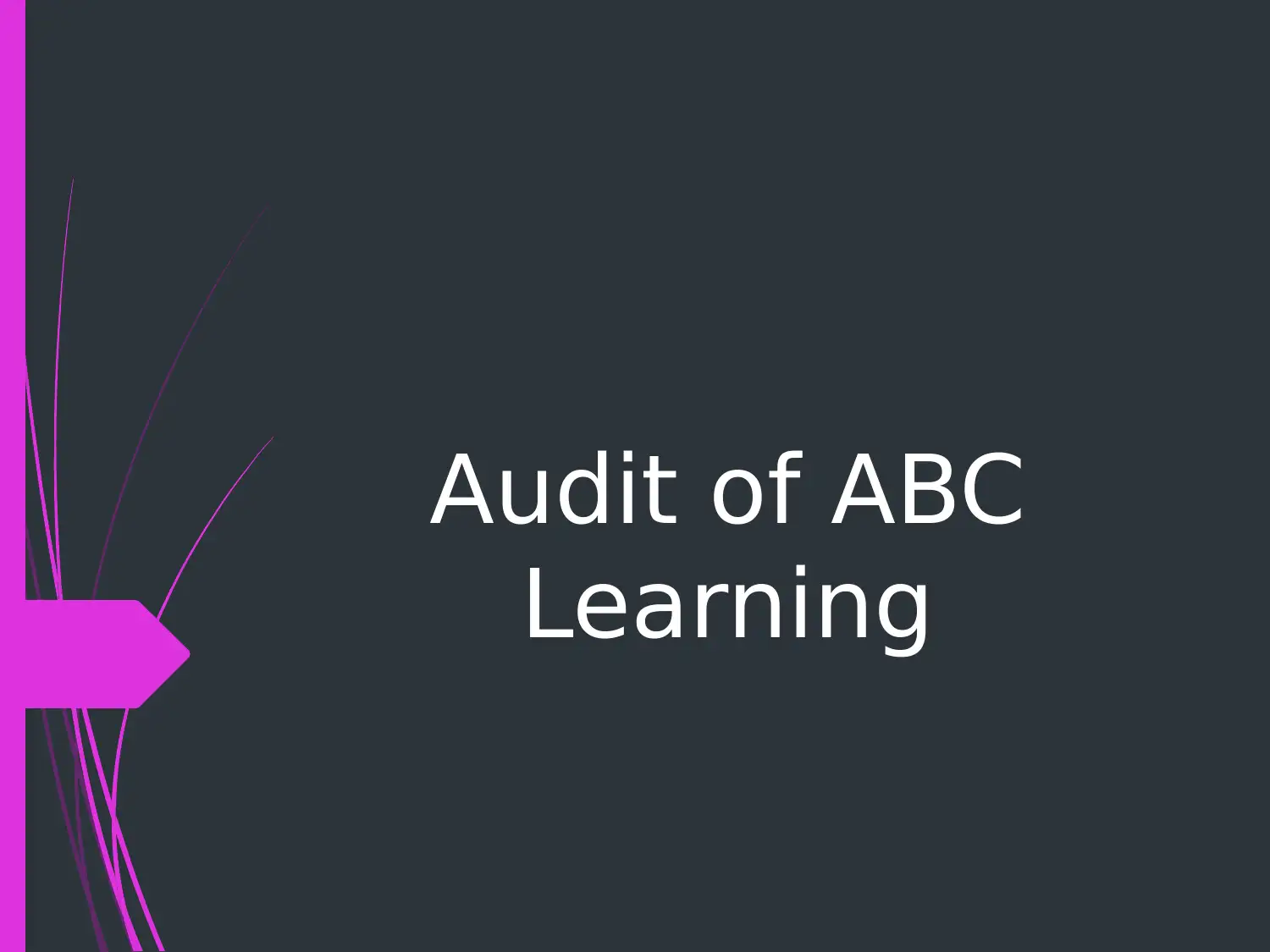
Audit of ABC
Learning
Learning
Paraphrase This Document
Need a fresh take? Get an instant paraphrase of this document with our AI Paraphraser
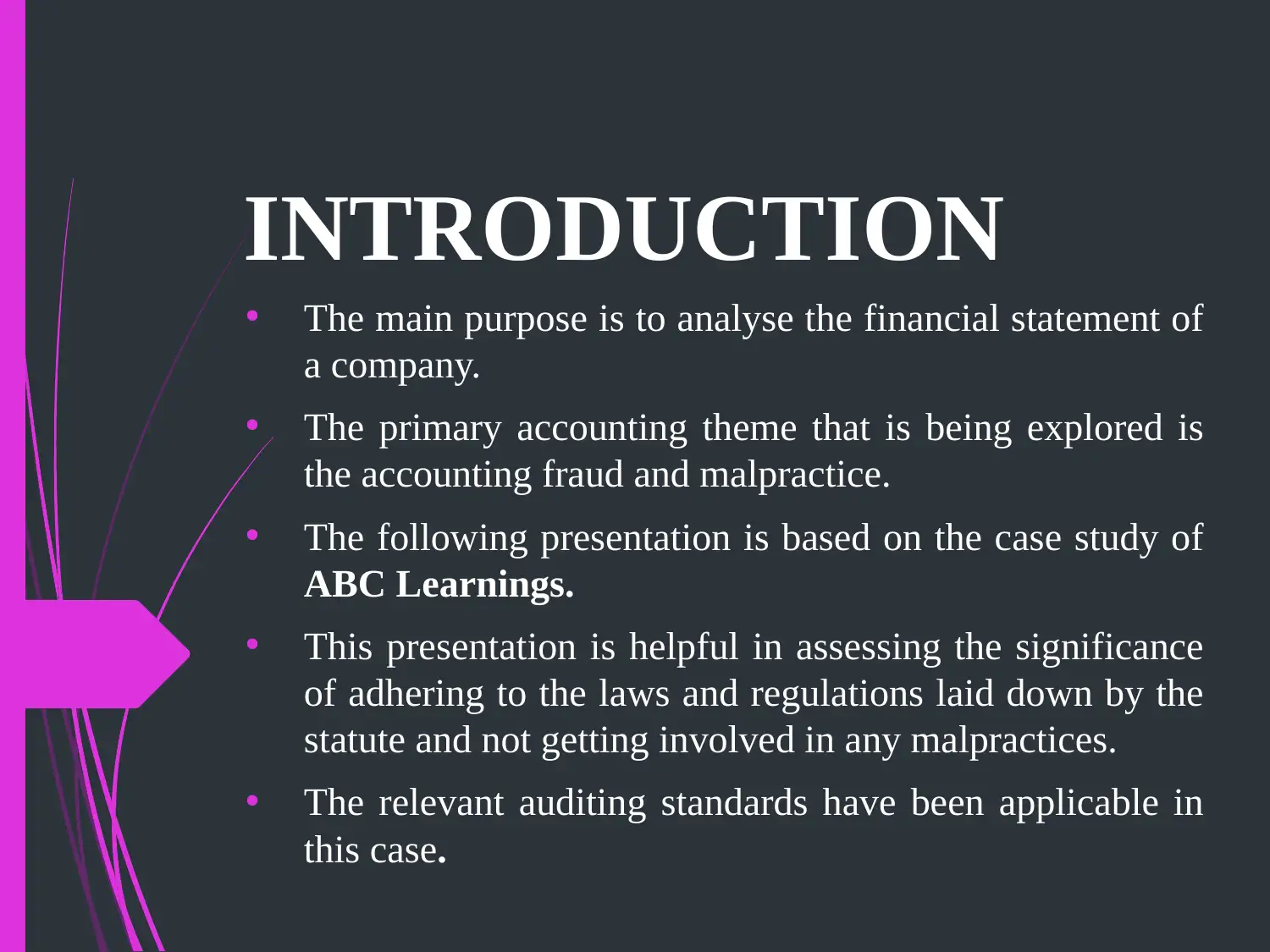
INTRODUCTION
• The main purpose is to analyse the financial statement of
a company.
• The primary accounting theme that is being explored is
the accounting fraud and malpractice.
• The following presentation is based on the case study of
ABC Learnings.
• This presentation is helpful in assessing the significance
of adhering to the laws and regulations laid down by the
statute and not getting involved in any malpractices.
• The relevant auditing standards have been applicable in
this case.
• The main purpose is to analyse the financial statement of
a company.
• The primary accounting theme that is being explored is
the accounting fraud and malpractice.
• The following presentation is based on the case study of
ABC Learnings.
• This presentation is helpful in assessing the significance
of adhering to the laws and regulations laid down by the
statute and not getting involved in any malpractices.
• The relevant auditing standards have been applicable in
this case.
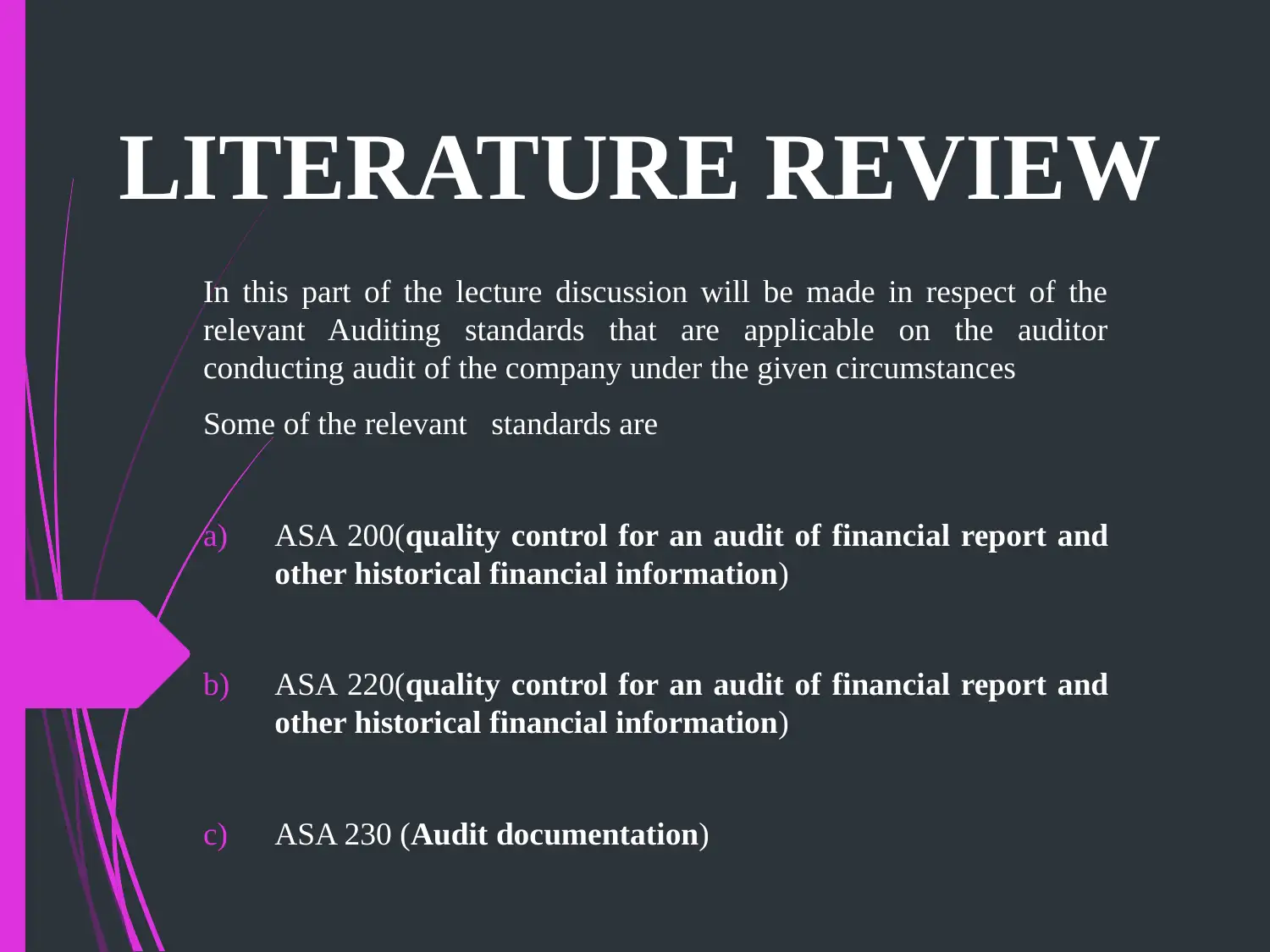
LITERATURE REVIEW
In this part of the lecture discussion will be made in respect of the
relevant Auditing standards that are applicable on the auditor
conducting audit of the company under the given circumstances
Some of the relevant standards are
a) ASA 200(quality control for an audit of financial report and
other historical financial information)
b) ASA 220(quality control for an audit of financial report and
other historical financial information)
c) ASA 230 (Audit documentation)
In this part of the lecture discussion will be made in respect of the
relevant Auditing standards that are applicable on the auditor
conducting audit of the company under the given circumstances
Some of the relevant standards are
a) ASA 200(quality control for an audit of financial report and
other historical financial information)
b) ASA 220(quality control for an audit of financial report and
other historical financial information)
c) ASA 230 (Audit documentation)
⊘ This is a preview!⊘
Do you want full access?
Subscribe today to unlock all pages.

Trusted by 1+ million students worldwide
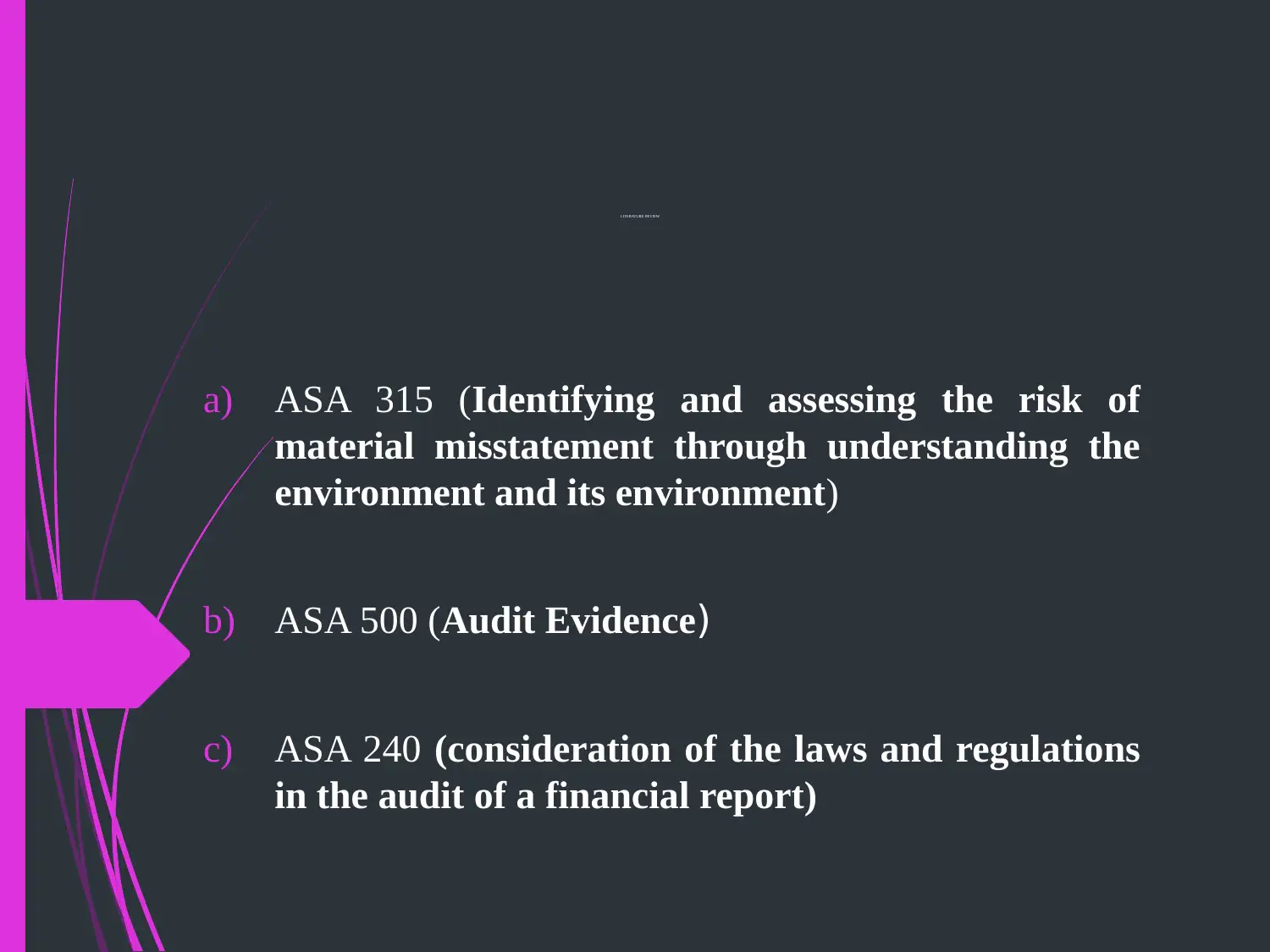
LITERATURE REVIEW
a) ASA 315 (Identifying and assessing the risk of
material misstatement through understanding the
environment and its environment)
b) ASA 500 (Audit Evidence)
c) ASA 240 (consideration of the laws and regulations
in the audit of a financial report)
a) ASA 315 (Identifying and assessing the risk of
material misstatement through understanding the
environment and its environment)
b) ASA 500 (Audit Evidence)
c) ASA 240 (consideration of the laws and regulations
in the audit of a financial report)
Paraphrase This Document
Need a fresh take? Get an instant paraphrase of this document with our AI Paraphraser
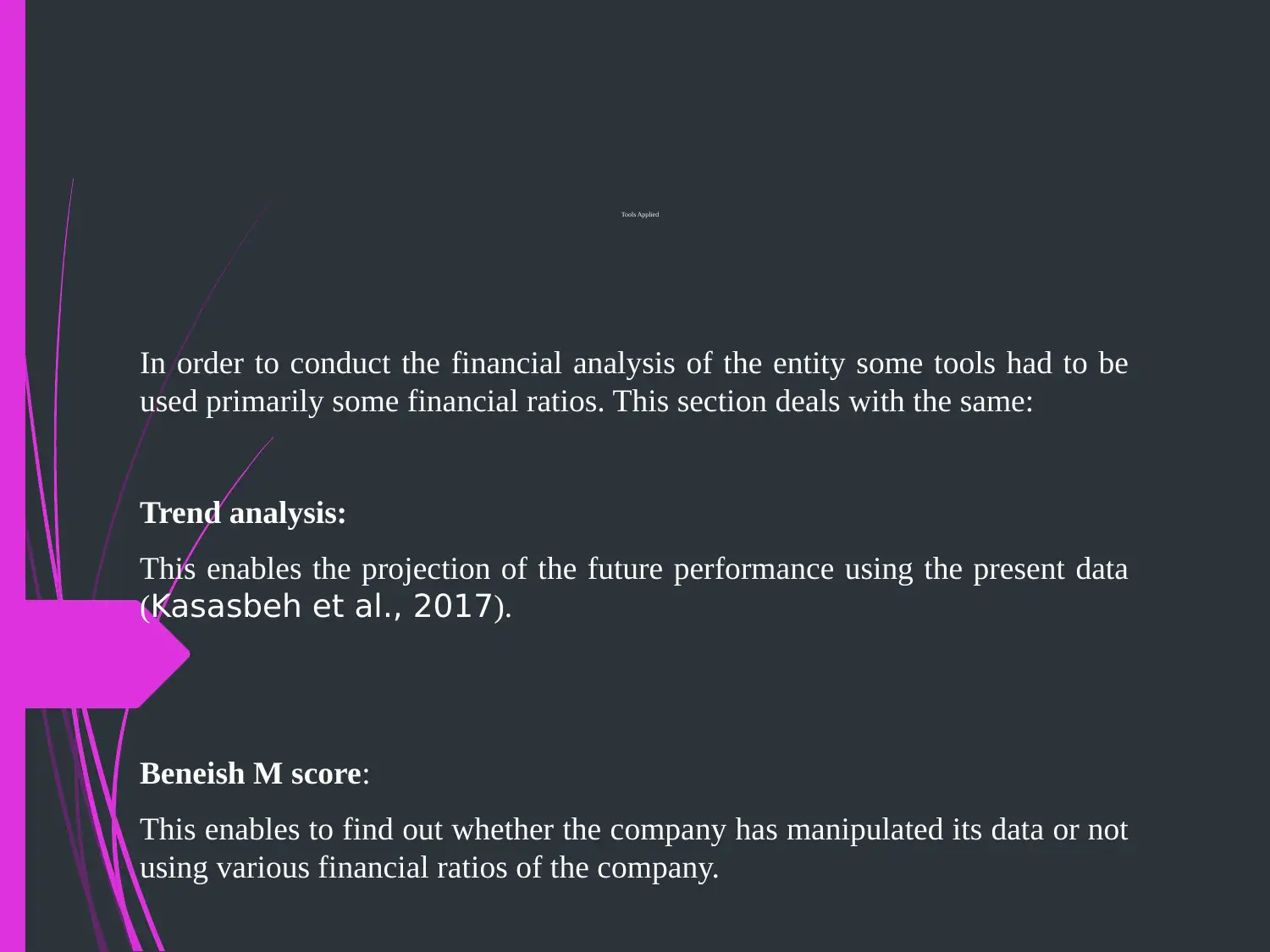
Tools Applied
In order to conduct the financial analysis of the entity some tools had to be
used primarily some financial ratios. This section deals with the same:
Trend analysis:
This enables the projection of the future performance using the present data
(Kasasbeh et al., 2017).
Beneish M score:
This enables to find out whether the company has manipulated its data or not
using various financial ratios of the company.
In order to conduct the financial analysis of the entity some tools had to be
used primarily some financial ratios. This section deals with the same:
Trend analysis:
This enables the projection of the future performance using the present data
(Kasasbeh et al., 2017).
Beneish M score:
This enables to find out whether the company has manipulated its data or not
using various financial ratios of the company.
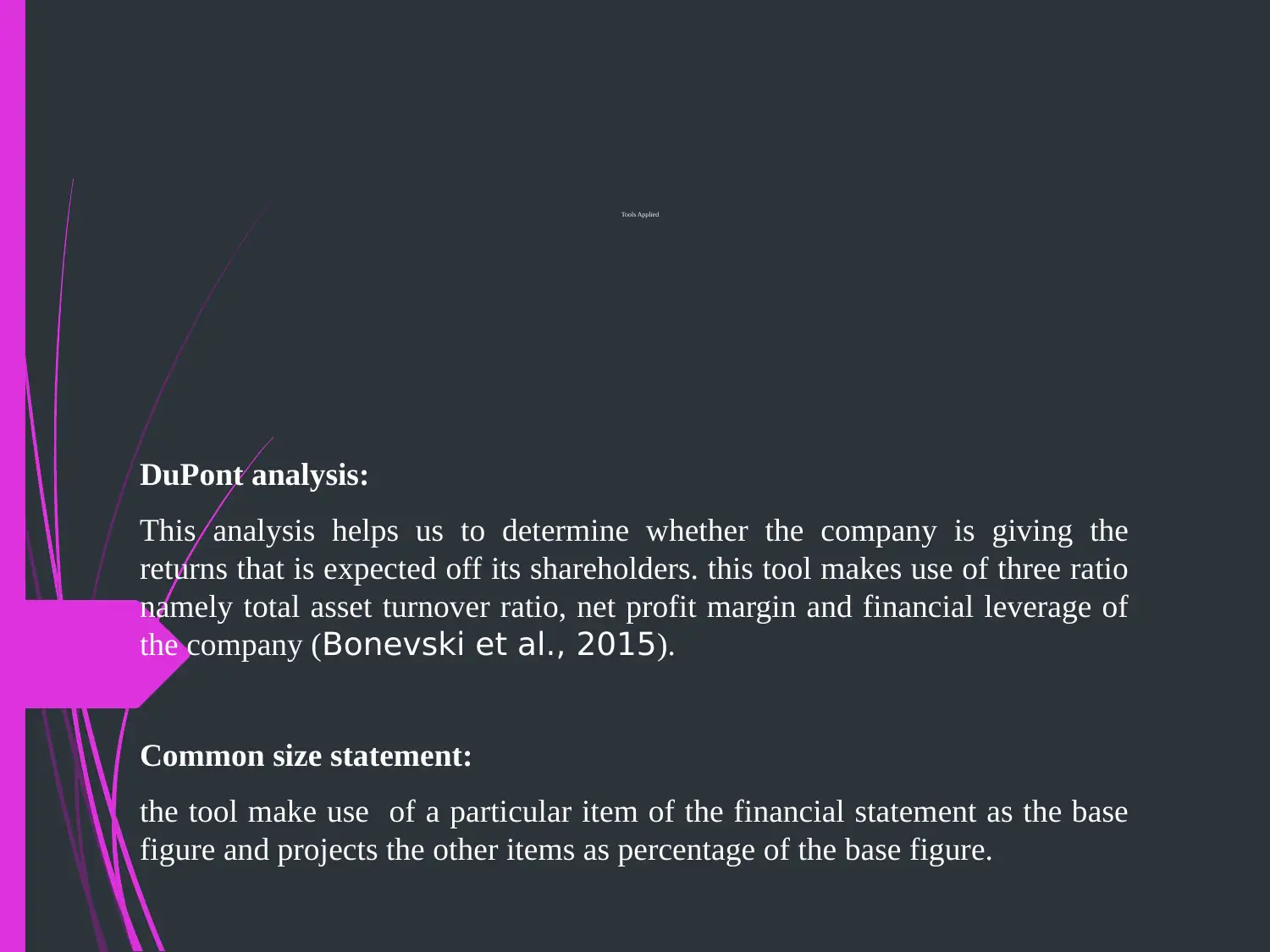
Tools Applied
DuPont analysis:
This analysis helps us to determine whether the company is giving the
returns that is expected off its shareholders. this tool makes use of three ratio
namely total asset turnover ratio, net profit margin and financial leverage of
the company (Bonevski et al., 2015).
Common size statement:
the tool make use of a particular item of the financial statement as the base
figure and projects the other items as percentage of the base figure.
DuPont analysis:
This analysis helps us to determine whether the company is giving the
returns that is expected off its shareholders. this tool makes use of three ratio
namely total asset turnover ratio, net profit margin and financial leverage of
the company (Bonevski et al., 2015).
Common size statement:
the tool make use of a particular item of the financial statement as the base
figure and projects the other items as percentage of the base figure.
⊘ This is a preview!⊘
Do you want full access?
Subscribe today to unlock all pages.

Trusted by 1+ million students worldwide
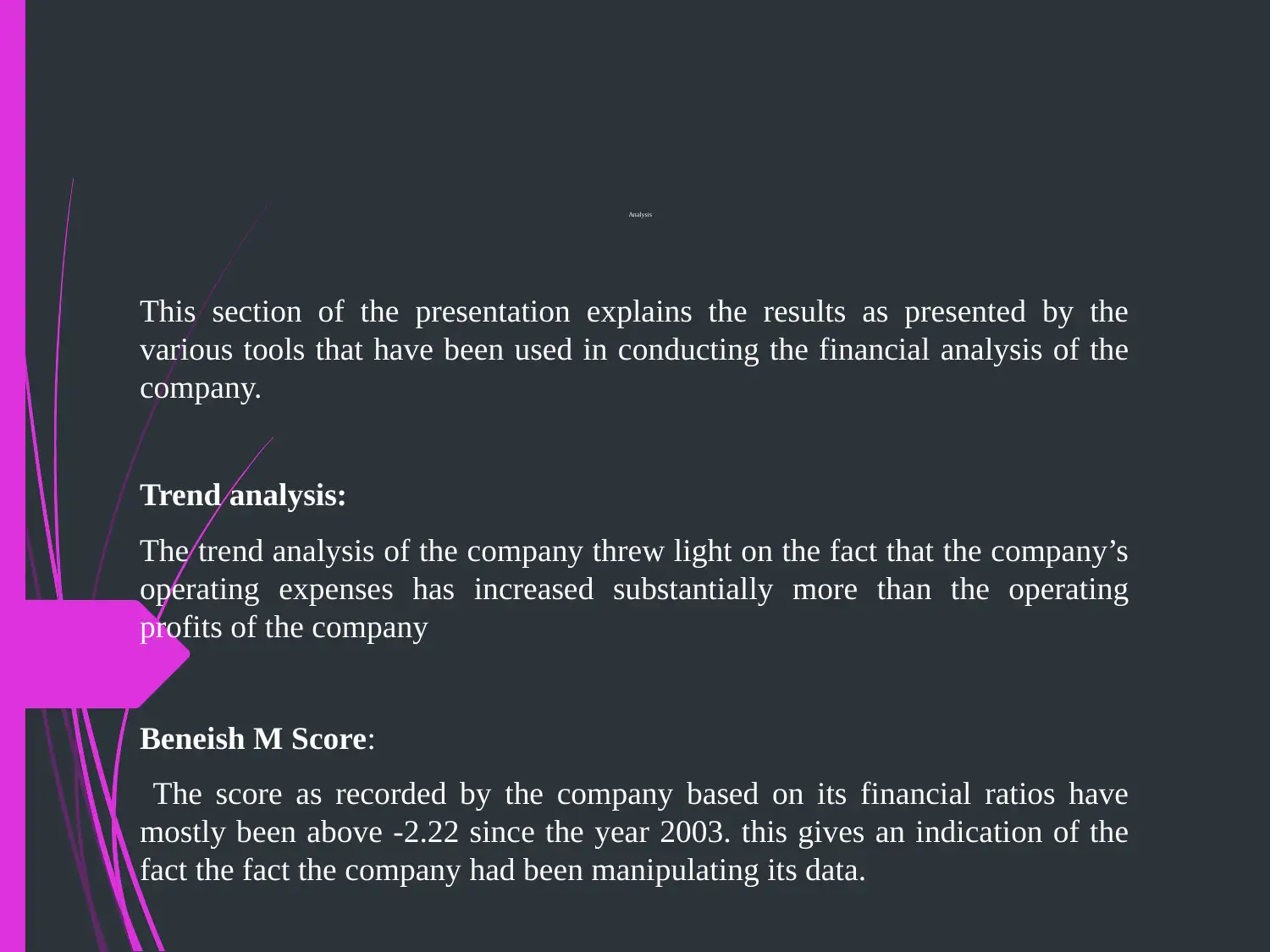
Analysis
This section of the presentation explains the results as presented by the
various tools that have been used in conducting the financial analysis of the
company.
Trend analysis:
The trend analysis of the company threw light on the fact that the company’s
operating expenses has increased substantially more than the operating
profits of the company
Beneish M Score:
The score as recorded by the company based on its financial ratios have
mostly been above -2.22 since the year 2003. this gives an indication of the
fact the fact the company had been manipulating its data.
This section of the presentation explains the results as presented by the
various tools that have been used in conducting the financial analysis of the
company.
Trend analysis:
The trend analysis of the company threw light on the fact that the company’s
operating expenses has increased substantially more than the operating
profits of the company
Beneish M Score:
The score as recorded by the company based on its financial ratios have
mostly been above -2.22 since the year 2003. this gives an indication of the
fact the fact the company had been manipulating its data.
Paraphrase This Document
Need a fresh take? Get an instant paraphrase of this document with our AI Paraphraser
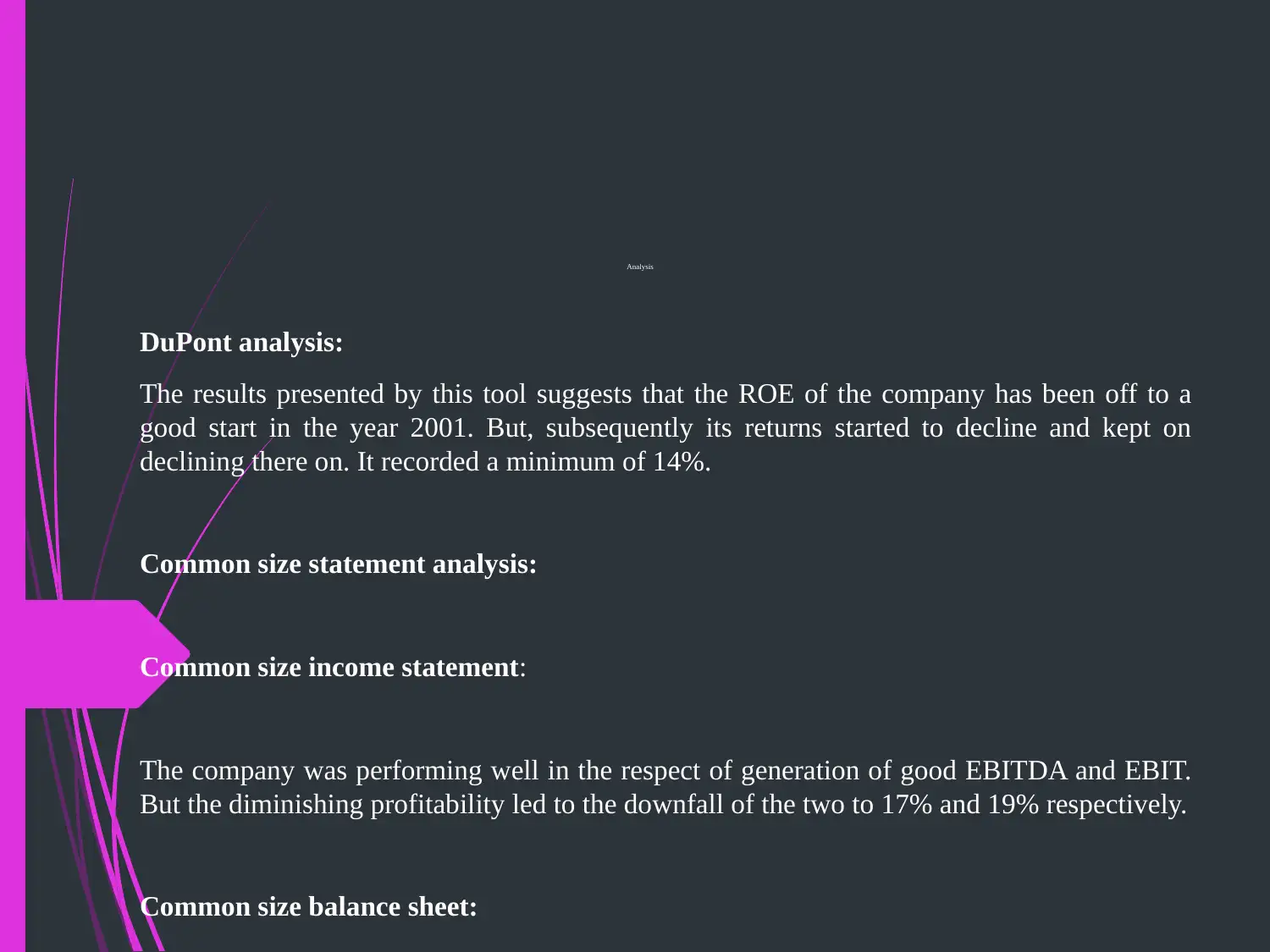
Analysis
DuPont analysis:
The results presented by this tool suggests that the ROE of the company has been off to a
good start in the year 2001. But, subsequently its returns started to decline and kept on
declining there on. It recorded a minimum of 14%.
Common size statement analysis:
Common size income statement:
The company was performing well in the respect of generation of good EBITDA and EBIT.
But the diminishing profitability led to the downfall of the two to 17% and 19% respectively.
Common size balance sheet:
DuPont analysis:
The results presented by this tool suggests that the ROE of the company has been off to a
good start in the year 2001. But, subsequently its returns started to decline and kept on
declining there on. It recorded a minimum of 14%.
Common size statement analysis:
Common size income statement:
The company was performing well in the respect of generation of good EBITDA and EBIT.
But the diminishing profitability led to the downfall of the two to 17% and 19% respectively.
Common size balance sheet:
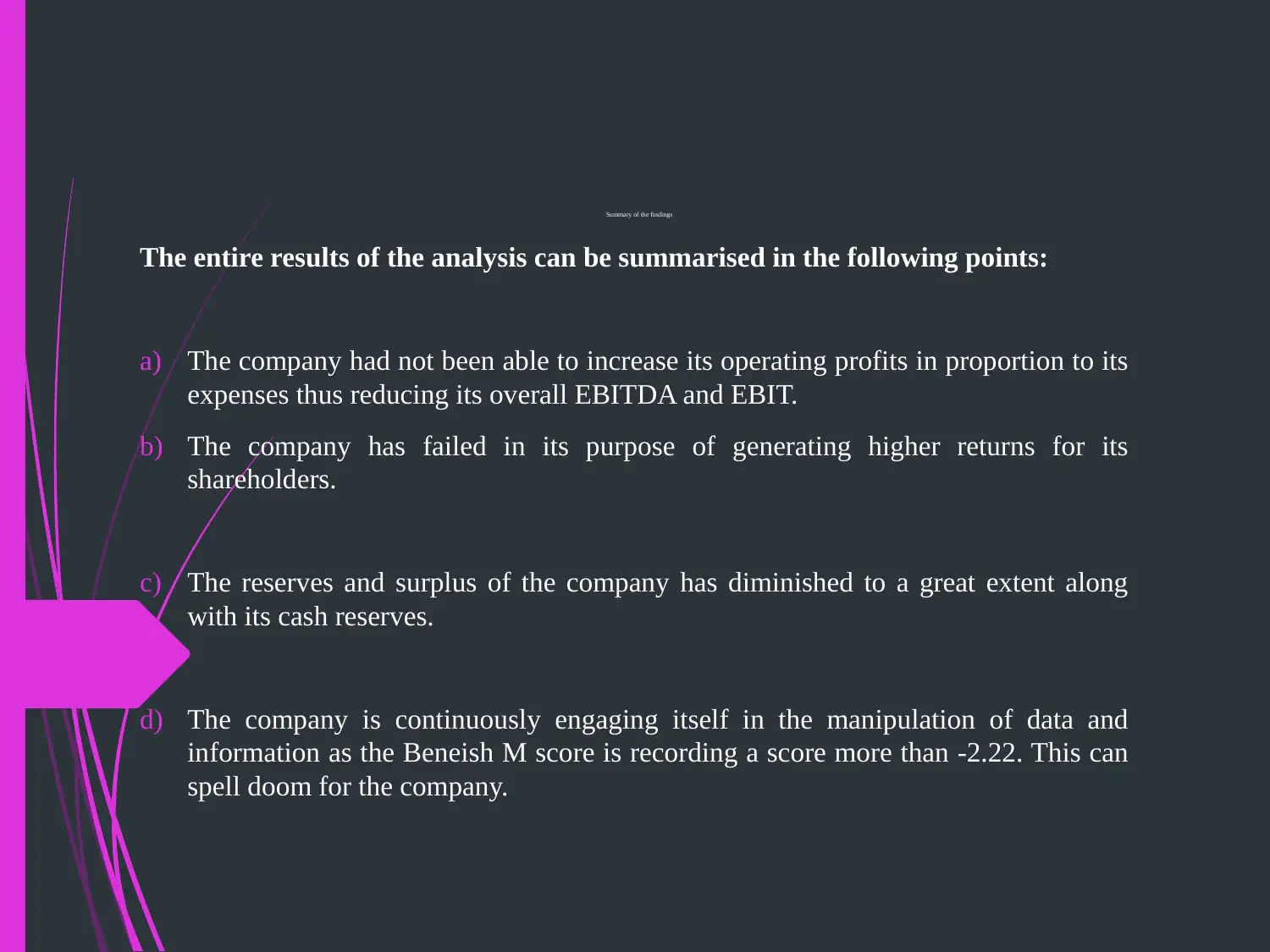
Summary of the findings
The entire results of the analysis can be summarised in the following points:
a) The company had not been able to increase its operating profits in proportion to its
expenses thus reducing its overall EBITDA and EBIT.
b) The company has failed in its purpose of generating higher returns for its
shareholders.
c) The reserves and surplus of the company has diminished to a great extent along
with its cash reserves.
d) The company is continuously engaging itself in the manipulation of data and
information as the Beneish M score is recording a score more than -2.22. This can
spell doom for the company.
The entire results of the analysis can be summarised in the following points:
a) The company had not been able to increase its operating profits in proportion to its
expenses thus reducing its overall EBITDA and EBIT.
b) The company has failed in its purpose of generating higher returns for its
shareholders.
c) The reserves and surplus of the company has diminished to a great extent along
with its cash reserves.
d) The company is continuously engaging itself in the manipulation of data and
information as the Beneish M score is recording a score more than -2.22. This can
spell doom for the company.
⊘ This is a preview!⊘
Do you want full access?
Subscribe today to unlock all pages.

Trusted by 1+ million students worldwide
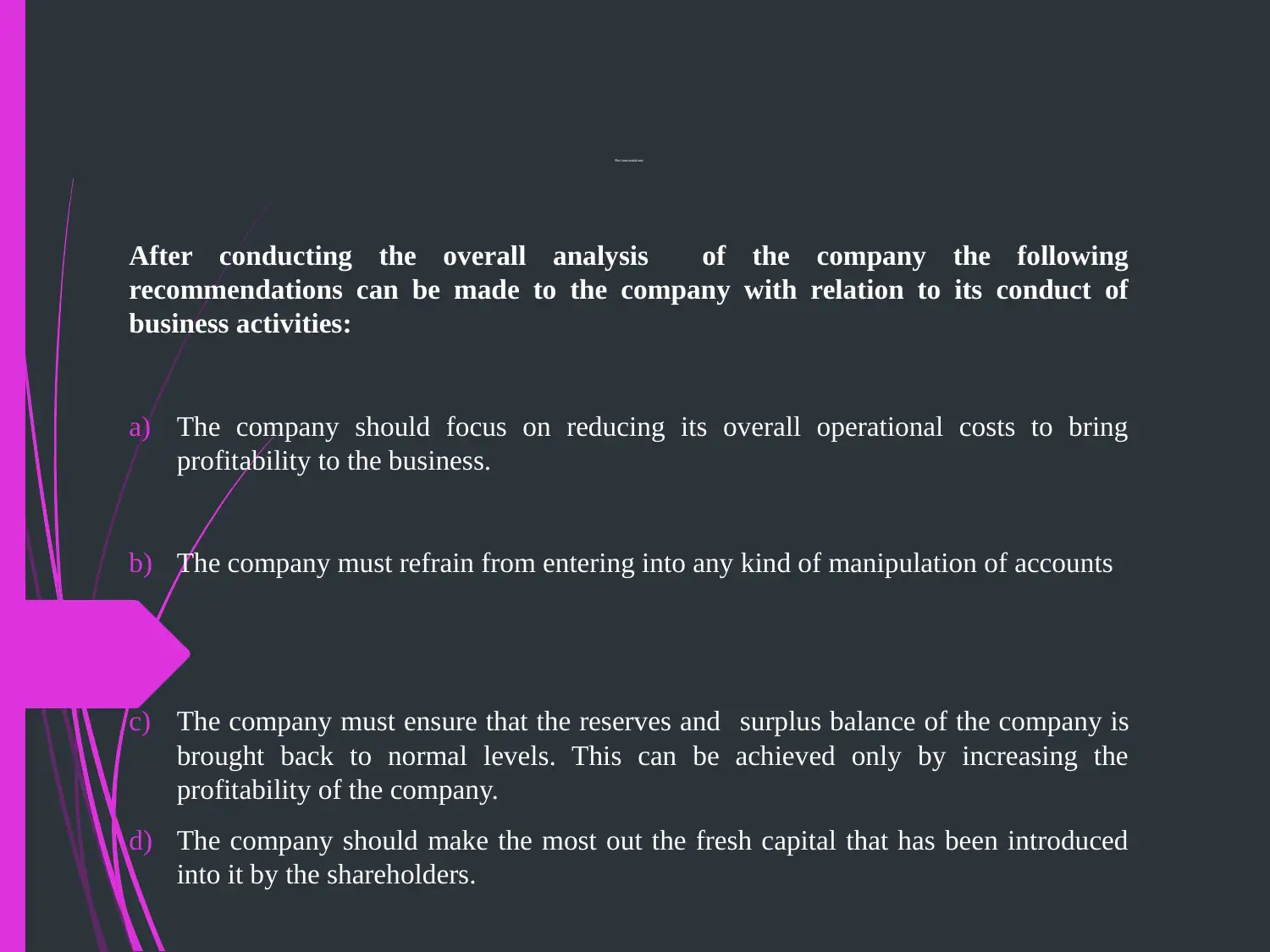
Recommendations
After conducting the overall analysis of the company the following
recommendations can be made to the company with relation to its conduct of
business activities:
a) The company should focus on reducing its overall operational costs to bring
profitability to the business.
b) The company must refrain from entering into any kind of manipulation of accounts
c) The company must ensure that the reserves and surplus balance of the company is
brought back to normal levels. This can be achieved only by increasing the
profitability of the company.
d) The company should make the most out the fresh capital that has been introduced
into it by the shareholders.
After conducting the overall analysis of the company the following
recommendations can be made to the company with relation to its conduct of
business activities:
a) The company should focus on reducing its overall operational costs to bring
profitability to the business.
b) The company must refrain from entering into any kind of manipulation of accounts
c) The company must ensure that the reserves and surplus balance of the company is
brought back to normal levels. This can be achieved only by increasing the
profitability of the company.
d) The company should make the most out the fresh capital that has been introduced
into it by the shareholders.
Paraphrase This Document
Need a fresh take? Get an instant paraphrase of this document with our AI Paraphraser
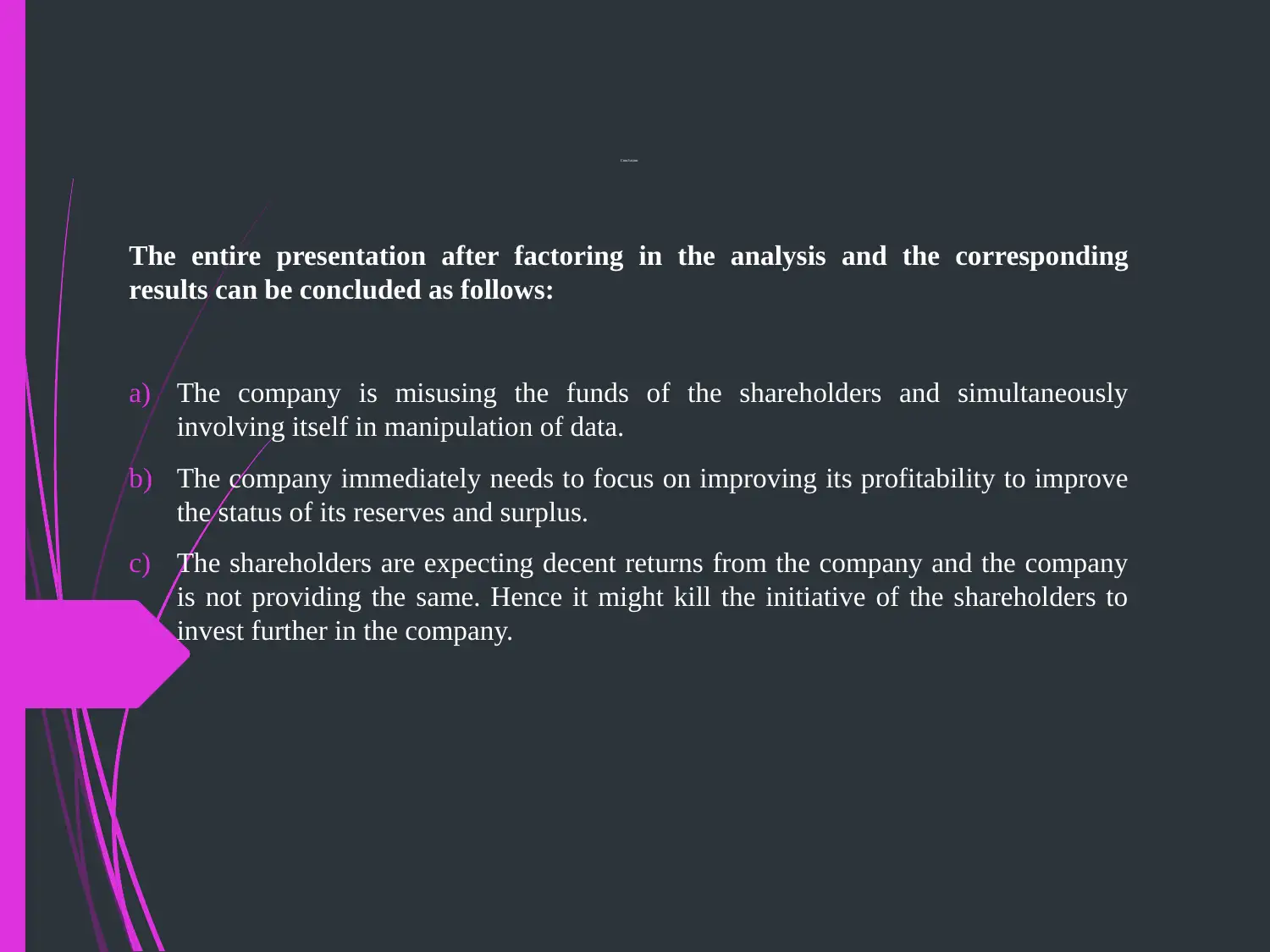
Conclusion
The entire presentation after factoring in the analysis and the corresponding
results can be concluded as follows:
a) The company is misusing the funds of the shareholders and simultaneously
involving itself in manipulation of data.
b) The company immediately needs to focus on improving its profitability to improve
the status of its reserves and surplus.
c) The shareholders are expecting decent returns from the company and the company
is not providing the same. Hence it might kill the initiative of the shareholders to
invest further in the company.
The entire presentation after factoring in the analysis and the corresponding
results can be concluded as follows:
a) The company is misusing the funds of the shareholders and simultaneously
involving itself in manipulation of data.
b) The company immediately needs to focus on improving its profitability to improve
the status of its reserves and surplus.
c) The shareholders are expecting decent returns from the company and the company
is not providing the same. Hence it might kill the initiative of the shareholders to
invest further in the company.
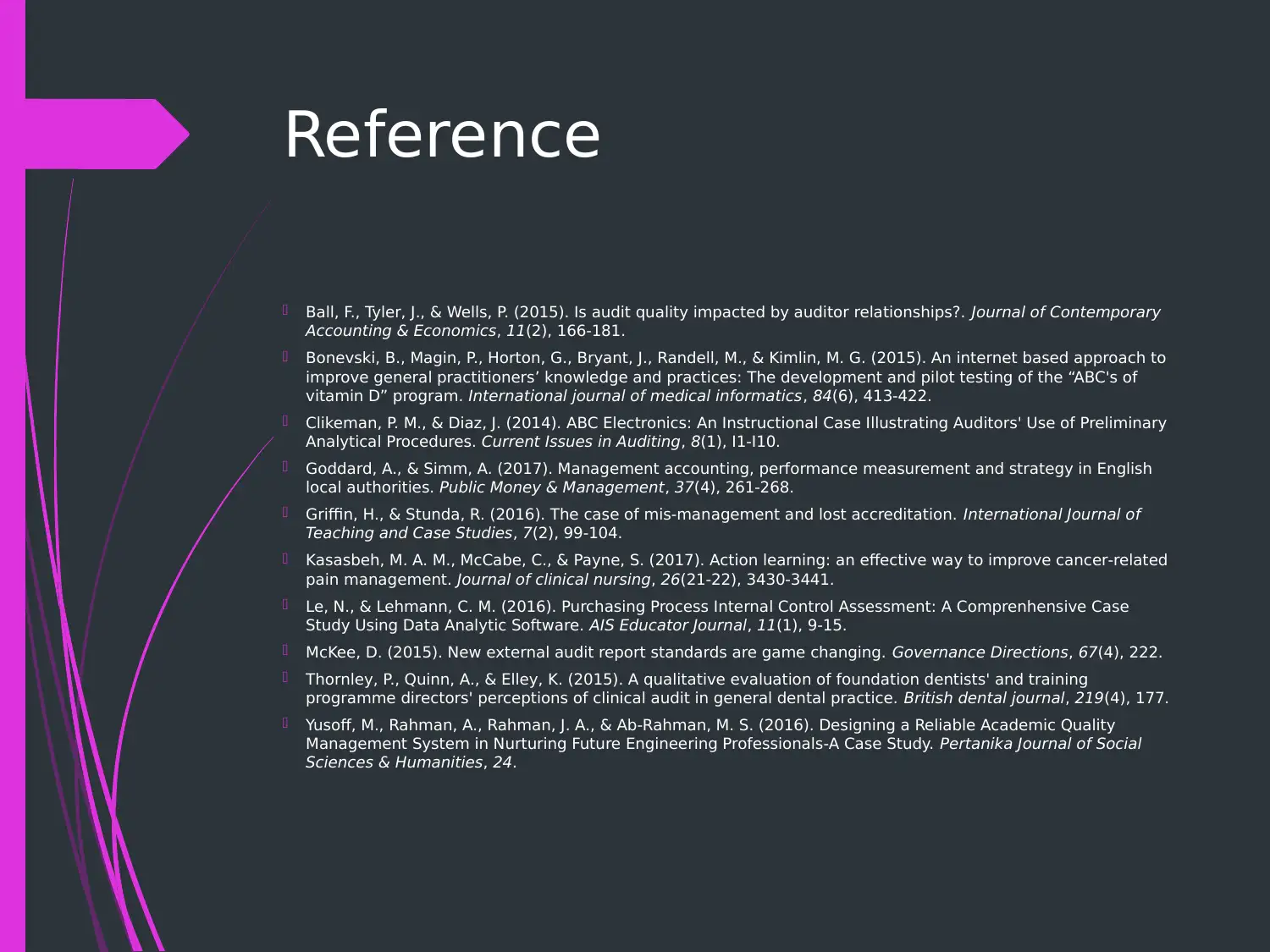
Reference
Ball, F., Tyler, J., & Wells, P. (2015). Is audit quality impacted by auditor relationships?. Journal of Contemporary
Accounting & Economics, 11(2), 166-181.
Bonevski, B., Magin, P., Horton, G., Bryant, J., Randell, M., & Kimlin, M. G. (2015). An internet based approach to
improve general practitioners’ knowledge and practices: The development and pilot testing of the “ABC's of
vitamin D” program. International journal of medical informatics, 84(6), 413-422.
Clikeman, P. M., & Diaz, J. (2014). ABC Electronics: An Instructional Case Illustrating Auditors' Use of Preliminary
Analytical Procedures. Current Issues in Auditing, 8(1), I1-I10.
Goddard, A., & Simm, A. (2017). Management accounting, performance measurement and strategy in English
local authorities. Public Money & Management, 37(4), 261-268.
Griffin, H., & Stunda, R. (2016). The case of mis-management and lost accreditation. International Journal of
Teaching and Case Studies, 7(2), 99-104.
Kasasbeh, M. A. M., McCabe, C., & Payne, S. (2017). Action learning: an effective way to improve cancer‐related
pain management. Journal of clinical nursing, 26(21-22), 3430-3441.
Le, N., & Lehmann, C. M. (2016). Purchasing Process Internal Control Assessment: A Comprenhensive Case
Study Using Data Analytic Software. AIS Educator Journal, 11(1), 9-15.
McKee, D. (2015). New external audit report standards are game changing. Governance Directions, 67(4), 222.
Thornley, P., Quinn, A., & Elley, K. (2015). A qualitative evaluation of foundation dentists' and training
programme directors' perceptions of clinical audit in general dental practice. British dental journal, 219(4), 177.
Yusoff, M., Rahman, A., Rahman, J. A., & Ab-Rahman, M. S. (2016). Designing a Reliable Academic Quality
Management System in Nurturing Future Engineering Professionals-A Case Study. Pertanika Journal of Social
Sciences & Humanities, 24.
Ball, F., Tyler, J., & Wells, P. (2015). Is audit quality impacted by auditor relationships?. Journal of Contemporary
Accounting & Economics, 11(2), 166-181.
Bonevski, B., Magin, P., Horton, G., Bryant, J., Randell, M., & Kimlin, M. G. (2015). An internet based approach to
improve general practitioners’ knowledge and practices: The development and pilot testing of the “ABC's of
vitamin D” program. International journal of medical informatics, 84(6), 413-422.
Clikeman, P. M., & Diaz, J. (2014). ABC Electronics: An Instructional Case Illustrating Auditors' Use of Preliminary
Analytical Procedures. Current Issues in Auditing, 8(1), I1-I10.
Goddard, A., & Simm, A. (2017). Management accounting, performance measurement and strategy in English
local authorities. Public Money & Management, 37(4), 261-268.
Griffin, H., & Stunda, R. (2016). The case of mis-management and lost accreditation. International Journal of
Teaching and Case Studies, 7(2), 99-104.
Kasasbeh, M. A. M., McCabe, C., & Payne, S. (2017). Action learning: an effective way to improve cancer‐related
pain management. Journal of clinical nursing, 26(21-22), 3430-3441.
Le, N., & Lehmann, C. M. (2016). Purchasing Process Internal Control Assessment: A Comprenhensive Case
Study Using Data Analytic Software. AIS Educator Journal, 11(1), 9-15.
McKee, D. (2015). New external audit report standards are game changing. Governance Directions, 67(4), 222.
Thornley, P., Quinn, A., & Elley, K. (2015). A qualitative evaluation of foundation dentists' and training
programme directors' perceptions of clinical audit in general dental practice. British dental journal, 219(4), 177.
Yusoff, M., Rahman, A., Rahman, J. A., & Ab-Rahman, M. S. (2016). Designing a Reliable Academic Quality
Management System in Nurturing Future Engineering Professionals-A Case Study. Pertanika Journal of Social
Sciences & Humanities, 24.
⊘ This is a preview!⊘
Do you want full access?
Subscribe today to unlock all pages.

Trusted by 1+ million students worldwide
1 out of 12
Related Documents
Your All-in-One AI-Powered Toolkit for Academic Success.
+13062052269
info@desklib.com
Available 24*7 on WhatsApp / Email
![[object Object]](/_next/static/media/star-bottom.7253800d.svg)
Unlock your academic potential
Copyright © 2020–2025 A2Z Services. All Rights Reserved. Developed and managed by ZUCOL.




